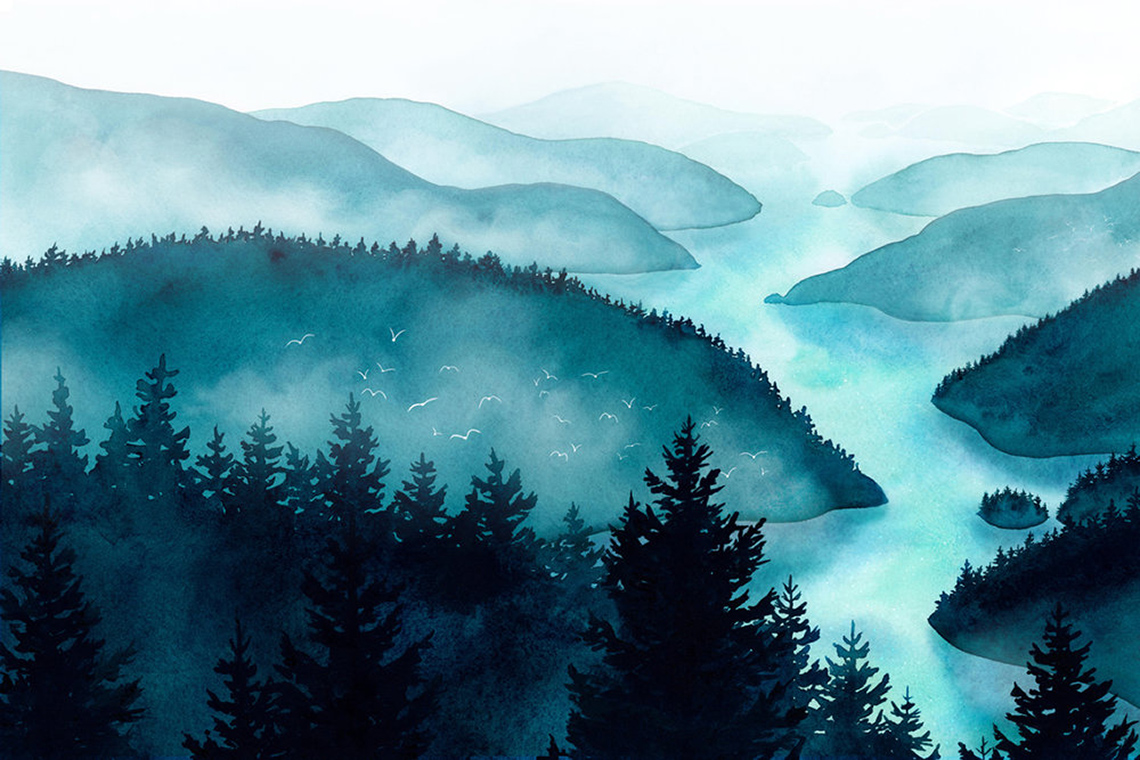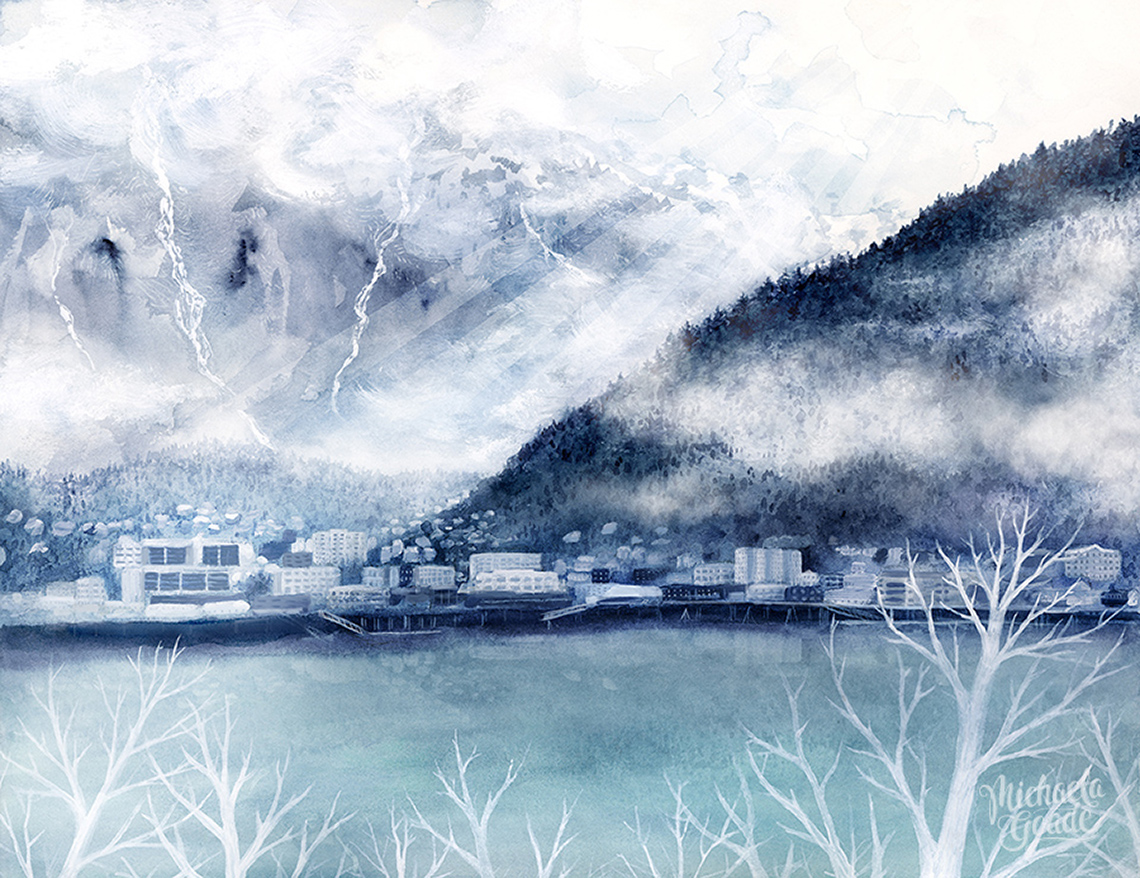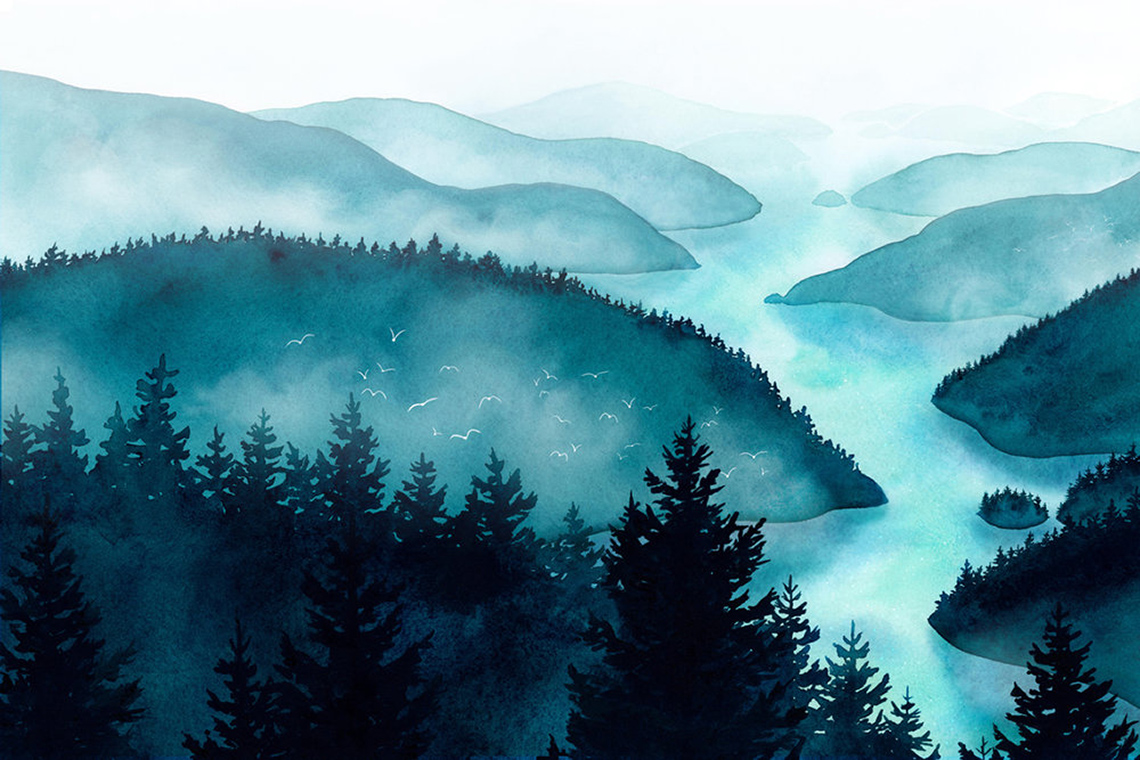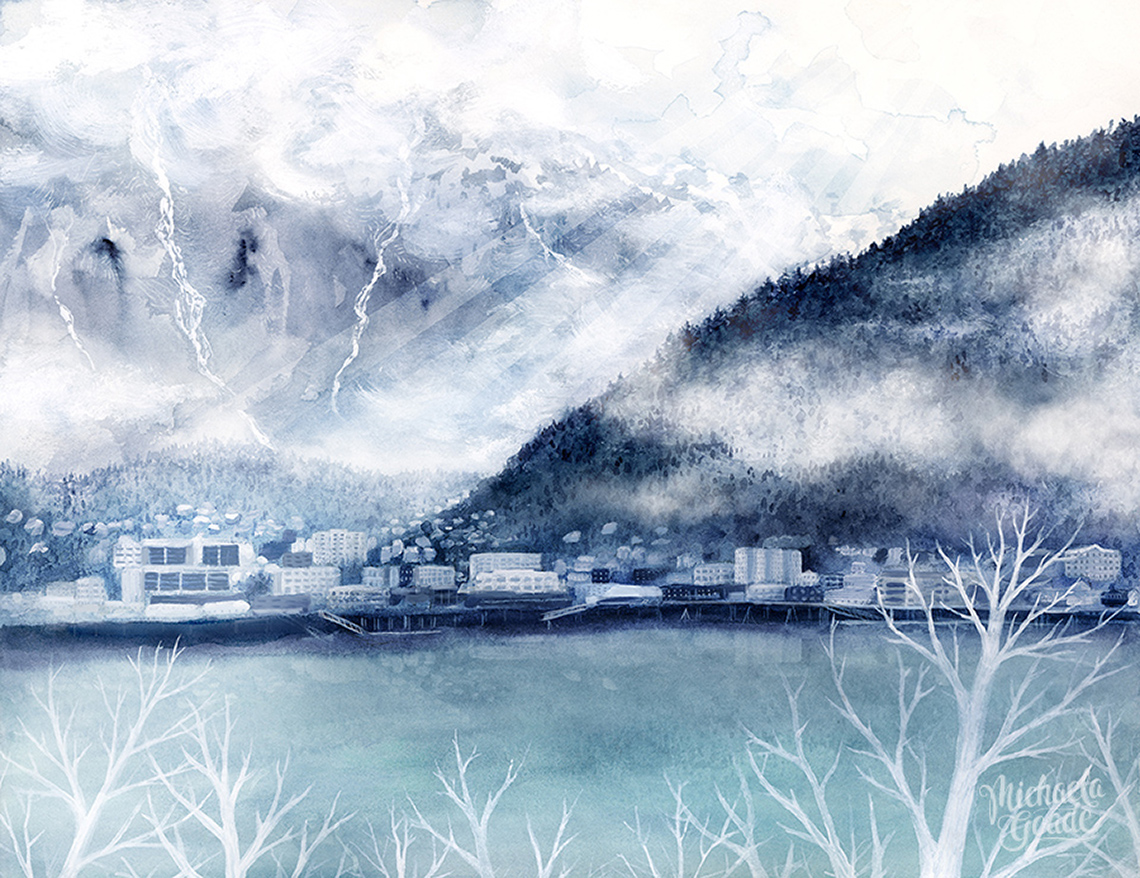Minds On
Let’s get started!
Creating a mood in artwork
How can an artist create a mood or feeling in their artwork?
Explore the following three images and descriptions.
All three images are examples from the artist Michaela Goade. For each of Goade’s pieces, describe the feeling or mood of the artwork in one word.
After each word, provide a very short description explaining why this example of Goade’s artwork made you feel this way.
Record your thoughts in a method of your choice.

This is a landscape of large hills surrounding a body of water. The art piece is created only using values of turquoise. The hills that are further in the background are lighter in shade. The hills in the centre of the piece are darker. The more detailed tree-lined hills are located in the front of the piece and are the darkest value. The water is lighter than the hills. There appears to be a mist rising over the hills and the water.
Now check out the next art piece!

In this piece, there is a town beside the body of water. The artwork is painted only using the cool colours of blue. The town and the water are very light in value. There is a large tree lined hill rising behind the town. The forested hill is very dark in value. At the front of this piece are the top branches of trees. The tree branches are light in value and have no leaves left on them. There is a mist that is rising over the town, into the hills beside and behind the town. The mist is a light value that contrasts with the dark hills in the background.
Share your words with a partner, if possible.
Exploring mood in artwork
Now, describe the mood or feeling of the following artwork in one word.

A landscape piece of a small body of water with a shoreline. The art piece is created with a variety of white, grey, and black values. The water is still. The shoreline has several canoes on it near the water. The opposite shoreline has grasses. The sky is the lightest value. The water is also a light value. The shoreline is a medium value. The canoes are a dark value and are contrasted against the shoreline and the water. The grasses are a medium value and contrast with the sky and the water.
What is similar or different about the piece you explored previously and Goade’s work?
Action
Get ready, get set…

Michaela Goade
In the Minds On, you explored some illustrations by Michaela Goade that each use a monochromatic colour scheme.
What is a monochromatic scale?
A monochromatic scale means that only one colour or hue is used. The colour has many variations of value. The colour’s value can be changed by adding white for lighter values and black for darker values. Tints are lighter values created by adding white to a colour. Shades are darker values created by adding black to a colour.
Michaela Goade was raised in the rainforest and on the beaches of Southeast Alaska, in traditional Lingít Aaní (Tlingit land). She currently lives in Sheet’ká (Sitka), Alaska. She is an enrolled member of the Tlingit and Haida Indian Tribes of Alaska. Her Tlingit name is Sheit.een and she is of the Kiks.ádi Clan (Raven/Frog) from Sheet’ká.
Goade’s work is inspired by the world around her. Her inspirations include the plants, animals, waters and lands in her community.
She also likes to create her work to show her appreciation and gratitude for the land and waters and to motivate others to protect the earth as well.
“I work to capture the feel of this environment whether it’s through the seemingly endless
shades of blues, greens and grays, the way mist and light interact with the trees and waves,
or the beautiful animals and plant life
that call this region home.”
– Michaela Goade
Let’s revisit Goade’s work entitled City by the Sea. Consider Goade’s quote and reflect on how she represents the mist and interaction between light, trees and water in her art piece.
Record your ideas in a method of your choice.

In this piece, there is a town beside the body of water. The artwork is painted only using the cool colours of blue. The town and the water are very light in value. There is a large tree lined hill rising behind the town. The forested hill is very dark in value. At the front of this piece are the top branches of trees. The tree branches are light in value and have no leaves left on them. There is a mist that is rising over the town, into the hills beside and behind the town. The mist is a light value that contrasts with the dark hills in the background.
Press ‘Answer’ to explore a potential answer.
Goade creates a cold feeling, like this is early in the morning. She creates a cold feeling by using almost white branches in front of a more colourful landscape. The trees in the foreground appear to be bare, which gives a feeling of late autumn or winter. There is a thick mist that is enveloping the hills behind the city by the water.
How do artists create a monochromatic scale of their chosen colour?
Mini task: Practice creating a monochromatic scale
Monocromatic colours work together to produce a soothing, calm effect, especially in blues and greens. These tints, shades, and tones combine to create a mood.
Check out the following steps to learn more about how an artist creates a monochromatic scale.
Press the following tabs to access the steps of creating a scale.
Create a long rectangle. You can use a piece of paper or a digital application. If using paper, create a rectangle with a ruler or by folding your paper edge. Divide your rectangle into five to seven equal sections. Each section should be about two to three centimetres wide.

Using a colour pencil crayon, pencil or digital application, colour in one end as dark as you can make it.

In the section next to the darkest value, colour in the section with a slightly lighter value. If you are using a colour pencil crayon or a pencil, press a little lighter to get a lighter value.

Continue to fill in each subsequent section with slightly lighter values each time. Do not colour in the final section, which will stay white as your lightest value.
Compare your monochromatic scale to the following example.

If you would like, create or describe the creation of your own monochromatic scale using your notebook, a digital application or an oral recording. If describing, consider how a colour could be lighter in each box.
Use your understanding of the monochromatic scale to answer the following questions. For each question, select true or false!
Reflecting on Goade’s artwork
Let’s return to Michaela Goade’s artwork from the Minds On.

Inside Passage by Michaela Goade
This is a landscape of large hills surrounding a body of water. The art piece is created only using values of turquoise. The hills that are further in the background are lighter in shade. The hills in the centre of the piece are darker. The more detailed tree-lined hills are located in the front of the piece and are the darkest value. The water is lighter than the hills. There appears to be a mist rising over the hills and the water.

City By the Sea by Michaela Goade
In this piece, there is a town beside the body of water. The artwork is painted only using the cool colours of blue. The town and the water are very light in value. There is a large tree lined hill rising behind the town. The forested hill is very dark in value. At the front of this piece are the top branches of trees. The tree branches are light in value and have no leaves left on them. There is a mist that is rising over the town, into the hills beside and behind the town. The mist is a light value that contrasts with the dark hills in the background.
How does Goade use the monochromatic scale to represent her feelings for the environment that surrounds her?
Record your ideas in a method of your choice.
Press ‘Hint’ to consider an idea about Goade’s artwork.
Consider how Goade might feel about the environment around her. If cool colours like blue and green create a soothing feeling, how is she effectively creating a particular mood?
Reflection
If you were going to create a piece of artwork using a monochromatic scale, with the idea of creating a soothing feeling of peace or calm, what would you want to create? Why?
Press ‘Answer’ to access a possible answer.
If I were to create a piece of artwork using a monochromatic scale, I would want to use the tints, shades, and tones of green and create an image of the field behind my street. The hills, trees, and meadow areas bring me peace. I visit this area often and always feel a sense of calm when I am there.
Value scale
In the Minds On, along with the artwork with a monochromatic scale, you also explored a, art piece with a value scale.

A landscape piece of a small body of water with a shoreline. The art piece is created with a variety of white, grey, and black values. The water is still. The shoreline has several canoes on it near the water. The opposite shoreline has grasses. The sky is the lightest value. The water is also a light value. The shoreline is a medium value. The canoes are a dark value and are contrasted against the shoreline and the water. The grasses are a medium value and contrast with the sky and the water.
What is a value scale?
A value scale is a tool used to explore a range of values. The value scale has a series of spaces to record each value. The values change from the lightest to the darkest. Having a wide range of values creates contrast and emphasis in art.
A drawing is considered a value drawing when it is created only with values of black and white and it has no colour. Black, white, and the many shades of grey in between the two are called values (and sometimes tones).
What is a range of values?
As an object turns away from the light source, less light can reach it and it gradually darkens. Eventually the object falls into shadow where light can no longer reach it. This incremental darkening of an object turning away from light is a value range. A value scale records all the values in a range for a specific art piece.
Explore the following example of a value scale. The example begins with white on one side, and each subsequent section is darker until the value scale ends in black.

A value scale with eight tones, starting with white. Each subsequent tone is a darker grey. The value scale ends in black.
Shading pencils can be used to create value in drawings. Pressing lighter or harder with a regular pencil also creates a changing value.

What are value names?
When we discuss values, there are value names we can use to describe them. Value names are the diverse words used to describe a range of light to dark tones from white to black. The nine value names are white, high light, light, low light, midvalue, high dark, dark, low dark and black.
Explore the following value scale with value names.

A value scale with a range of nine light to dark tones from white to black. Each value is labelled with a value name. The nine value names are white, high light, light, low light, midvalue, high dark, dark, low dark and black.
We can use the value scale to create depth by suggesting volume and shadows.
Depth can be created by shading with your pencil like when you explored creating a monochromatic scale, or created by shading techniques including hatching, cross-hatching, stippling and scumbling.
Explore the following examples of shading techniques.
Identifying shading techniques
Explore the following landscape image. The landscape is created using a value scale that includes hatching, cross-hatching, stippling and scumbling.

Portfolio
Track your progress
How does this piece use the value scale to create depth and bring feeling to the artwork?
Record your ideas in a method of your choice.
Press ‘Answer’ to check out a possible answer.
This piece uses dark cross-hatching to create depth and shadows on the mountains. The light unshaded areas could be snow because it appears on the mountains, the fields and the rooftops of the farm buildings. There is light hatching in the field to reveal areas of tall grass.
Mini task: Practice creating a value scale with shading
It’s your turn to create your own value scale or a description of a value scale. You can choose a shading technique from hatching, cross-hatching, stippling and scumbling.
Create a long rectangle. You can use a piece of paper or a digital application. If using paper, create a rectangle with a ruler or by folding your paper edge. Divide your rectangle into five to seven equal sections. Each section should be about two to three centimetres wide.

Using a pencil or digital application, shade in one end as dark as you can make it with your chosen shading technique. To create a dark value with shading, make your lines or dots as close together as you can.

In the section next to the darkest value, shade the section with a slightly lighter value. If you are using a pencil, make your lines or dots further apart to create a slightly lighter value.

Continue to fill in each subsequent section with slightly lighter values each time.
Compare your shading value scale to the following example.

Consolidation
Putting it all together
Create your own monochromatic artwork

You will use either the monochromatic scale or the value scale to create your own landscape of a space in your life or one that inspires you. You may also create a detailed description of how you could use a monochromatic scale or a value scale to design a landscape piece.
Consider the mood and/or feeling you would like to create, like Michaela Goade did. What does your chosen space mean to you?
Materials Needed
Materials needed
Possible materials you might need for this learning activity:
- a blank sheet of paper or an art journal
- drawing and colouring materials such as pencils, crayons and eraser
- an electronic tablet for drawing
- any other art materials you like to use
Student Success
Exploring digital creation options
When you are considering digital creation options, explore the variety of digital applications available!
Note to teachers: See your teacher guide for collaboration tools, ideas and suggestions.
Press the following tabs to access a variety of options for creating your monochromatic artwork.
Describe your chosen landscape. How will you use either a monochromatic scale or a value scale? Specify the details of your chosen place that create a feeling or mood you would like to communicate.
Materials you will need for this option:
- any size of paper
- pencil (shading art pencils optional)
- eraser
Select an object or a picture of a landscape. The landscape could be real or imaginary. Begin by investigating which parts of the landscape are darkest to lightest.
Select your art materials based whether you are using a monochromatic value scale or a shading value scale.
Sketch or describe your plan for the piece and how you plan to use the method, or scale to create your piece.
Create your design or piece using your plan!
Use a digital program to create your landscape piece. Select an object or a picture of a landscape. The landscape could be real or imaginary. Begin by investigating which parts of the landscape are darkest to lightest.
Decide if you are using a monochromatic value scale or a shading value scale.
Digitally sketch or describe your plan for the piece and how you plan to use the method, or scale to create your piece.
Create your design or piece using your plan!
Portfolio
Art analysis
Describe your artwork.
Identify a challenge you encountered while creating your drawing or description. If you were able to, how did you work through this challenge?
What part of your work are you most proud of? Why?
Record your reflections in a method of your choice.
Consider adding your work to your Art Portfolio!
Reflection
As you read the following descriptions, select the one that best describes your current understanding of the learning in this activity. Press the corresponding button once you have made your choice.
I feel…
Now, expand on your ideas by recording your thoughts using a voice recorder, speech-to-text, or writing tool.
When you review your notes on this learning activity later, reflect on whether you would select a different description based on your further review of the material in this learning activity.



